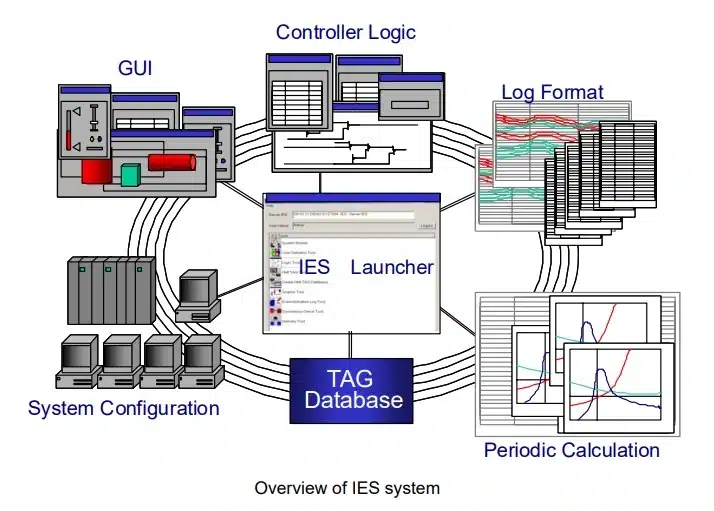The IES system (Integrated Engineering Station) consists of various engineering tools and databases for the system that allow the following tasks to be performed on the system:
- Create and tune the control logic
- Create and maintain the Tag database
- Create and modify the graphical user interface
- Adjust parameters for the system components
- Define and modify the report formats
- Define and modify performance calculations and logs
- Support to maintain consistency among the databases

Integrated Engineering Station Databases
Databases in the IES system (Integrated Engineering Station) are categorized as follows:
- Controller Databases: All control logic data, CAD logic data, controller configuration data, and
all Tag information - System Configuration Databases: Hardware and software configuration parameter
- Initial Tag Database: All Tag information
- HMI Tag Database: HMI Tag information
- Graphics Databases: All graphical user interface data
- Log Databases: Contents and formats for performance calculation logs and event activation logs.
Most of the IES system (Integrated Engineering Station) tools create or modify at least one of these databases. The Tag database is central to all of the databases, because they refer to Tag information in order to handle the corresponding process data. All input and output signals in the system are tagged to identify them, and all databases use Tags to identify data exchanged between them. Thus, Tags represent the plant actuators and sensors, as well as data signals transferred between components.
Integrated Engineering Station Tools
The IES system (Integrated Engineering Station) tool consists of various tools:
1) Launcher
This is used to launch the various tools. The launcher window appears automatically when the IES is started.
2) System Builder
When the system is first implemented or when the system configuration is modified, the configuration
information must be specified with this tool.
4) Logic Tool
The function of the Logic tool is to create and maintain the controller logic and the Tag database. The
major functions of the control logic tool are programming, monitoring, tuning, and simulation of the
control logic
5) HMI Tag Tool
The HMI Tag tool provides functions to create the HMI Tag database from the Tag information in the
HMI database.
6) Create HMI Tag Database Tool
The Create HMI Tag Database tool provides functions to create the Initial Tag database from the Tag
information in the Control database.
7) Graphic Tool
The Graphic tool allows the construction of displays and interfaces for system monitoring and control.
Stylish and user-friendly interfaces can be created easily. The Graphic tool provides for the
modification not only of custom graphic displays, but also windows that are provided as a standard part
of the system, such as trends and alarm displays.
8) Periodic Calculation Log Formula Tool
The Periodic Log Formula tool defines the periodic (performance) calculation formulas for estimating
the status of plant potential, running efficiency, life span, etc. The tool also provides for the definition
of curve-fitting data.
9) Periodic Calculation Log Format Tool
The Periodic Calculation Log Format Tool is used to define the printout and display formats for
periodic logs at each output interval.
10) Event Activation Log Tool
The Event Activation Log Tool defines parameters for Event Activation Logs, i.e., the Pre- & Post Trip Logs and Multiple Snapshot Log.
11) Consistency Check
The Consistency check tool verifies that the Tag numbers used in the various databases such as the
Graphics database and the Performance-Calculation Log database are defined correctly in the Initial
Tag database. This tool creates a copy of the database files ready to be used for the delivery operation.
12) Delivery
To make modification to any of the databases effective on the on-line system, all databases must be
redistributed to the HMI stations or the controller, or both. The Delivery tool delivers the databases to
the HMI stations and maintains the revision number of each database on the stations.
RELATED SEARCHES: